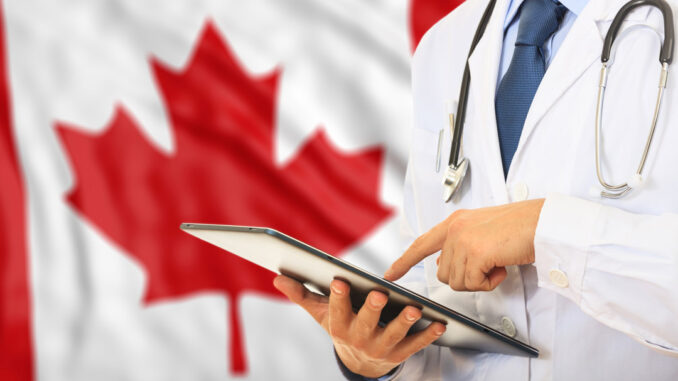
Is Canada getting its money’s worth out of its publicly funded health-care insurance system?
This is the question that surfaced out of a recent analysis by the Fraser Institute which concluded that a typical family of four will pay an estimated $15,847 for public health care insurance this year, and that doesn’t include the cost of private medical insurance or other out-of-pocket deductibles, dental or vision care, eye care, drugs, research or capital spending which, according to the Canadian Institute of Health Information (CIHI) estimates, cost $80 billion in 2019.
The report – The Price of Public Health Insurance 2022 ─ reveals that, over the past 25 years, the cost of public health-care insurance increased for the average Canadian family almost four times as fast as the cost of clothing, and about twice as fast as the cost of food, shelter and average incomes. This comes at a time when primary care offices, emergency rooms and ICUs are being swamped by growing backlogs of patients and medical staffs are burning out. As Canadian Medical Association president Dr. Katharine Smart recently characterized to media, “What’s clearly coming is the collapse of the current health-care system. What we’re not seeing is the political will to take that seriously.”
As Bachus Barua, director of health policy studies at Fraser and lead author of the study emphasized:
“Understanding how much Canadians actually pay for health care and how much that amount has increased over time is an important first step for taxpayers to assess the value and performance of the health-care system, and whether it’s financially sustainable.”
As Fraser analysts emphasize in the introduction of their report: health care is not free: “While Canadians may not be billed directly when they use medical services, they pay a substantial amount of money for health care through the country’s tax system.” In effect ─ you pay for health care every time you buy a pair of shoes, a few litres of gas, a case of beer, donuts from Tim Hortons, tickets for the Maples Leafs, Flames or Canadiens.
Compared to the most highly developed European countries which have universal health-care systems (e.g., the Swiss, French, Germans, Dutch, Danes), Canada’s total costs of health care as a percentage of Gross Domestic Product are within the same ballpark – between 11 and 12.5 per cent. But most European countries eschew Canada’s single-payer monopoly model that blocks private insurers from any role in providing basic health insurance. Norway actually funds virtually all health-care services directly, but has a user fee stipulation which was anathema to framers of the Canada Health Act. (Universal health care means that all residents are required to have health insurance.)
Yet, in most of these European countries, access to high-quality care is relatively quick and complete – very few headline-grabbing reports about service shutdowns or backlogs. All allow, and in fact some, such as Germany, count on non-profit insurers to administer hospital and medical services (albeit according to government-mandated standards). Germany also has far fewer health-care bureaucrats than Canada.
True, the UK’s vaunted National Health Service is currently undergoing Canada-style ER backlogs, staff shortages and burnout, and long waits for specialty referrals. But it also has a buoyant parallel private-insurance sector that takes some of the heat off of the NHS to growing numbers of citizens (who have the means) of less cumbersome options for getting the health care when they need it.
But nowhere – in either the UK or the EU – are there the months-long waits for medically necessary procedures that 1,425,517 Canadians had to tolerate in 2021.* Assuming that each person waited for only one procedure, this means that 3.7 per cent of Canadians were on wait lists for treatment in 2021. In addition, the waiting time from referral by a general practitioner to a specialist took an average of 11.1 weeks in 2021. The shortest waits were in Ontario, the longest in PEI (by twice).
* Fraser report: Waiting Your Turn 2021.
Among these delayed procedures, hip replacements are constantly top priorities. A 2018 Commonwealth Fund multinational survey comparing in-patient hip replacement procedures for patients 65 or older in 10 countries showed that the Swiss were top of the list with 16.9 per thousand population, Americans next with 15.6 and Germans with 14.5. Last on the list of 10 was Canada with 9.6. Ditto the administration of MRI exams per thousand population: Germany scored 149, France 120, Canada came in ninth out of 10, with 51.
As authors of the Fraser study concluded: “Our hope is that these figures will enable Canadians to more clearly understand just how much they pay for public health-care insurance, and how that amount is changing. With a more precise estimate of what they really pay, Canadians will be in a better position to decide whether they are getting a good return on the money they spend on health care.”
| Average tax bill for Health Care Insurance | Average cash income | Average tax bill for Health-Care Insurance |
|---|---|---|
| Unattached individuals | $50,140 | $4,907 |
| Two parents, one child | $154,287 | $15,917 |
| Two parents, two children | $156,086 | $15,847 |
| One parent, one child | $73,805 | $5,812 |
By Milan Korcok
Medical writer Milan Korcok was a founding Features Editor for The Canada’s Medical Post and has served as Contributing Editor for the Canadian Medical Association Journal for many years. Milan is a dual Canadian/U.S. citizen. He resides permanently in Florida. He welcomes your comments at mkorcok@aol.com.
